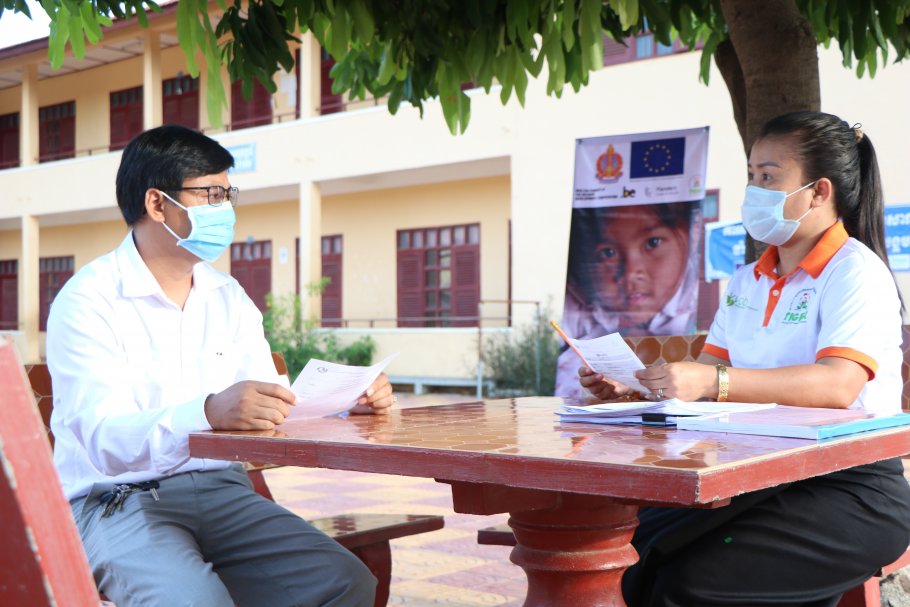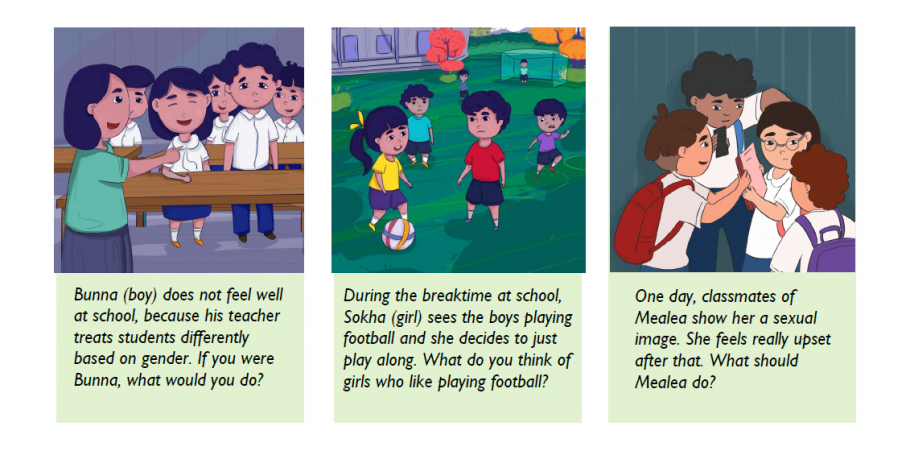
The Teaching for Improved Gender Equality and Responsiveness’ (TIGER) project aimed to ‘ensure that primary and lower secondary school children are protected from School-Related Gender-Based Violence (SRGBV), enabling their equitable participation in all spheres of life at school and at home.’ The Ministry of Education, Youth and Sport (MoEYS) and the Ministry of Women’s Affairs (MoWA) have developed an Action Guide on gender-responsive education, through cooperation with VVOB – education for development (VVOB), Kampuchean Action for Primary Education (KAPE), Puthi Komar Organisation (PKO) and Gender and Development for Cambodia (GADC). This project is implemented with the financial support of the European Union, Belgium and Flanders.
For the full story and to download the Action Guide on gender-responsive education, scroll down. But first: check out the story of Phy Srey Nich, grade 5 student at Samdach Chea Sim Primary School. She is one of the final beneficiaries of the project; 4,800 girls and 4,800 boys in 40 primary and lower secondary schools in Battambang Province.
More people’s stories of change are available on VVOB Cambodia’s YouTube Channel. Enjoy!
Creating violence-free schools
Gender-based violence, and school-related gender-based violence (SRGBV) in particular, is a major obstacle to achieving gender equality. The education system provides opportunities for innovative, effective, and sustainable interventions to prevent violence against and between children, and for changes of attitudes and beliefs towards gender roles. Teachers, and school leaders in particular, are fundamental in transforming practices, attitudes and values, and instilling in learners the understanding of gender equality and the practice of non-violent behaviour.
In the TIGER project 40 primary and lower secondary schools and the Teacher Education College in Battambang were supported to transform their schools into gender-responsive learning environments.

Teachers and school leaders unlock their potential with the Action Guide
Teaching for improved gender equality and responsiveness means that teachers and school leaders are aware of gender challenges in the education system and are equipped to overcome and/or counter those challenges, as well as to create a (more) gender aware climate in their classrooms and schools. Gender-responsive teachers and school leaders provide all learners the opportunity to develop their own talents, irrespective of gender stereotypes.
To develop and or strengthen teachers’ and school leaders’ understanding of gender responsiveness and to provide tools and strategies to establish a gender responsive school climate, the project developed an Action Guide on gender-responsive education.
The flip-over Action Guide consist of a booklet for school management (one side) and a booklet for teachers (other side). Each side of the booklet contains chapters relevant to the target group. These two sides share the same introductory part, which provides basic knowledge on gender and school-related gender-based violence. The booklet for school management focuses on gender-responsive school leadership and parental/community involvement. The booklet for teachers provides guidelines and tools to implement gender-responsive teaching into their classroom. The document has been endorsed by The Ministry of Education, Youth and Sport.
To amplify the messages from the Action Guide on the elimination of school-related gender-based violence, the project developed Information, Education and Communication (IEC) materials for different target groups: 3 posters for teachers and school leaders, 2 booklets for children and 3 brochures for parents.
Storytelling app on gender (in)equality

What would you do, if you were Bunna, Sokha or Mealea? As the story unfolds, you, as reader, use text commands to control the characters and influence their environment. That is how you experience the consequences of your choices.
The interactive storytelling app is a digital library that contains stories for teachers, students, parents and community members. The stories relate to real life situations in which gender (in)equality or stereotyping occurs in schools and communities.
Curious? Please download the storytelling app “រឿងអបរ់".
Let us know what you think
The Action Guide and other materials are open educational resources. As its authors, VVOB, KAPE, PKO and GADC gladly invite any other likeminded organisations to use those materials in their activities. Gender equality can only be achieved with broad stakeholder engagement and concerted efforts. However, even though the Action Guide is construed as a self-read resource for teachers and school leaders, the authors strongly recommend the guide to be integrated into broader capacity development trajectories for education personnel and practitioners.
VVOB welcome any feedback and questions about the TIGER materials and are open to discuss any queries. Please reach out to miranda.degruiter@vvob.org.
Webinar on promoting violence-free schools and gender-responsive education in Cambodia
On December 14, 2020, a closing webinar on promoting violence-free schools and gender-responsive education in Cambodia was organised. This webinar highlighted the key achievements of the TIGER project, shared the results of the impact study on gender-responsive and violence-free school environments and advocated for continued focus on gender-responsiveness in education. You can watch the recording below.
Thank you to our donors!





